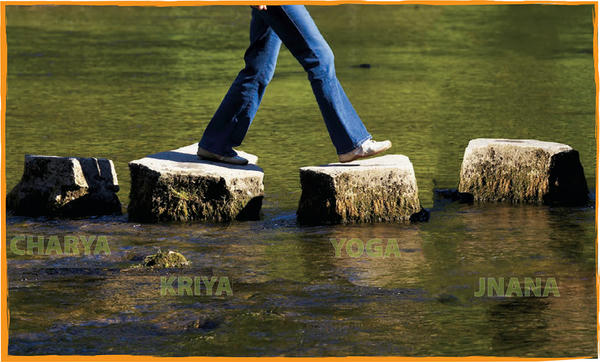30 What Are the Path’s Four Stages?§
Four stages define the path which we follow, one after the other. Unlike this hiker who leaves one rock behind to step onto the next, we keep the previous stages alive as we stride forward.§
SHUTTERSTOCK§
When created by Lord Siva, the soul is young and immature. Its process of “growing up” over many lifetimes happens in four stages. This is much like the development of a lotus flower. First it sends its roots into the pond’s mud, then it grows a stem and leaves that reach the water’s surface. Finally it blossoms in the full sun. Yet each previous stage of growth is still there supporting the flower. Siva’s grace guides this process so that we learn and grow toward the light through experience, under the divine law of karma. As the soul progresses through each stage, it becomes less instinctive and more spiritual. Siva is continually creating souls, so at any point in time, there are on the Earth young souls, adolescent souls, middle-aged souls and old souls. The four padas, stages of maturation, are charya, kriya, yoga and jnana. Charya is good conduct and humble service, attending the temple and helping with temple chores. Here, the main work is harnessing the instincts and developing virtuous qualities. Kriya is the stage of devotion, or love of God, expressed through home puja and temple worship. Yoga is the period of meditation and inner striving under a guru’s guidance. At this stage, the temple is a sacred space for contemplation as Siva’s veiling power gives way to His revealing grace. Jnana is the wisdom state, where the realized soul sees himself as one with the temple Deity. These stages are also experienced in each lifetime. As children, we learn good conduct, as summarized in the yamas and niyamas. Then we are taught worship, expressing heart-melting devotion for God, Gods and guru. Next, we may learn to meditate, with the goal of gaining true wisdom. The four padas are not alternate ways, but progressive steps on a one path called San Marga. Nor does the soul give up the practices of one pada when it enters the next. Thus the mature soul in jnana is a paragon of wisdom, yoga, devotion and virtue. The greatest yogis still love and worship Siva.§
GURUDEVA: Some people think, “When you get to the yoga stage, you don’t have to do the worship, you don’t have to do the service. You just do the yoga.” In our Saiva Siddhanta philosophy, when you get to the yoga stage and the jnana stage, you still enjoy the worship, you still enjoy the service. These are dear and intricate parts of your life.§

